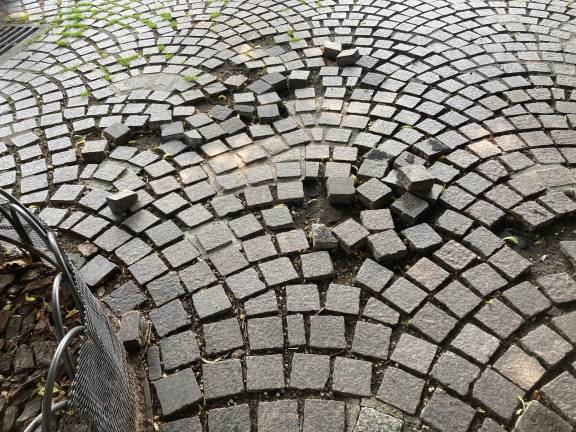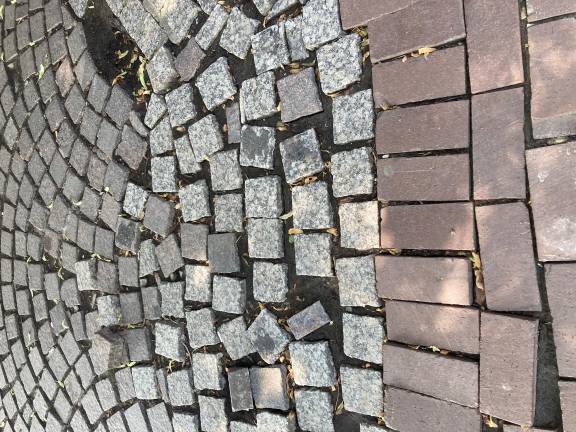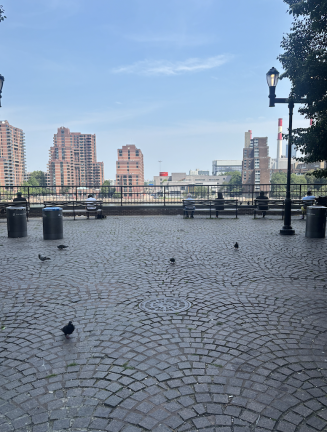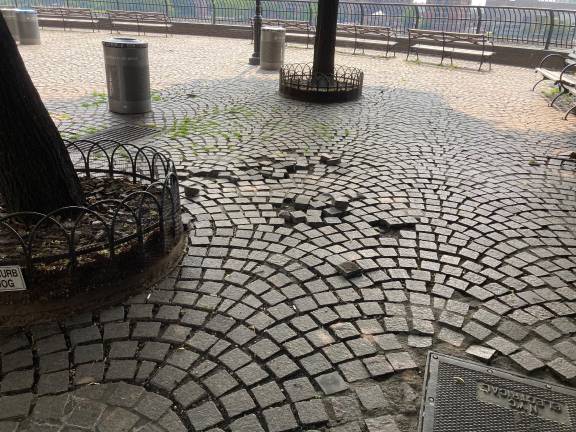Danger: East 72nd St. Overlook Left in Disrepair Despite $250k Donation from Hospital
UES residents remain frustrated as DOT remains inactive on long-neglected public overlook.




Though sitting in a breathtaking position, the East 72nd Street cul-de-sac, which overlooks the East River, has sat largely untouched by the city agency responsible for its upkeep for almost two decades. Despite a $250,000 donation in 2024 from cancer center Memorial Sloan Kettering, Department of Tranportation inactivity means the cracked and weed-lined cul-de-sac has remained in disrepair.
Perched above the FDR Drive on the farthest eastern point of East 72nd street, the historic cobblestone cul-de-sac, many Upper East Side residents say, has become increasingly hazardous.
The controversy surrounding the cul-de-sac dates back almost 40 years. In 1985, the developer Sheldon Solow obtained permission to construct a 47-story glass apartment building at 525 East 72nd Street, an area dominated by low-rise buildings. In exchange for the building rights, the city required Solow to transform what was once a dead-end into a public overlook. He was to be held responsible for its sanitation, upkeep, and security on a 20-year contract.
Though Solow upheld his end of the deal, all space oversight vanished after the 20-year maintenance agreement expired in 2005. While technically under DOT jurisdiction, the cul-de-sac no longer functioned as an active street, creating a bureaucratic gray zone with no agency willing to assume responsibility.
Since 2005, the overlook has fallen into disrepair. Overgrown weeds and uneven pavers dominate the space, despite its high visibility and large amounts of daily foot traffic from residents, hospital staff, and families.
In recent years, the cul-de-sac has become dangerous. Resident Andrew Lefkowitz, who has lived near the cul-de-sac since 1994, fell on the pavers in 2024 while walking his dog, requiring five stitches in his hand.
“I was walking my dog downstairs, right outside the building, and my dog pulled a little on the leash, so it threw me off balance, and my ankle turned on the loose pavers, and I went down,” Lefkowitz said. “I dropped the leash, the dog ran away, and I tried to break my fall with my hand, but the palm of my hand went right into one of the loose pavers and I got five stitches in my hand.”
Lefkowitz is one of several residents who have been injured. A neighbor who wished to remain anonymous fell in December 2023, suffering significant facial injuries.
Such incidents are concerning to Lefkowitz, who believes the area is becoming hazardous for elderly people and younger civilians.
“With these loose stones everywhere, it’s dangerous, you know, [for] elderly people walking, and kids running. I’m in pretty good shape. I’m pretty coordinated, but I just turned the wrong way and the loose stones tripped me right down,” Lefkowitz said.
According to Lefkowitz, residents from surrounding buildings have recently stepped up in community efforts, replacing the deteriorated wood slats in the overlook benches, pruning trees, and relighting the area. However, the most pressing issue, the crumbling pavement, remains untouched.
Multiple organizations have been interested in taking over the restoration project in the past decades, but each effort has eventually unraveled.
In 2022, the nearby Hospital for Special Surgery (HSS)—a number of whose patients and employees utilize the space—began negotiations with the city to obtain responsibility for the space. However, after months of negotiation, the project fizzled out, as HSS was unwilling to meet the conditions presented by the DOT lawyers.
Later, the Parks Department showed interest in converting the cul-de-sac into a green space. Though there was some enthusiasm for the project, this effort also fell apart as it became clear that DOT would not cede jurisdiction of the land.
More recently, momentum returned when Memorial Sloan Kettering (MSK) proposed the construction of a new 50-story tower nearby. Required to present a $10-million community-benefits package, Council Member Julie Menin specifically negotiated $250,000 for repairs on the cul-de-sac to be transferred to the DOT.
However, since then, residents have revealed that nothing has happened.
According to Nick Economou, an Edgewater Board of Directors member, residents are concerned regarding how the DOT may choose to manage the project.
“Our biggest fear is that the DOT is going to do the minimal, or just do what it takes to make it, quote, unquote, safe,” Economou said. “We’re very afraid that they’re going to come down, look at the conditions, and pour blacktop over our beautiful pavers.”
For Lefkowitz, there are still slivers of optimism, but they come with years of disappointment.
“I’ve got cautious optimism,” Lefkowitz said. “There’s always talk—‘We’re going to improve it’—but it just never really happens fast enough.”
Though the local community is proud of the earlier projects, the core problem remains and must be addressed by the DOT. Until any real work begins, residents believe that the cobblestones remain more of a hazard than a historic charm.
“I get the historic part—you know, the cobblestones—but it’d be great if they could just put something down that’s smooth,” Lefkowitz said. “Maybe better pavers, or even cement, or something, I don’t know, because these loose stones are really dangerous.”
The Department of Transportation did not respond to a request for comment by press time.